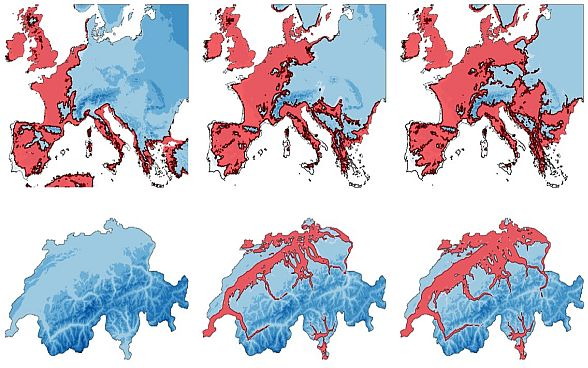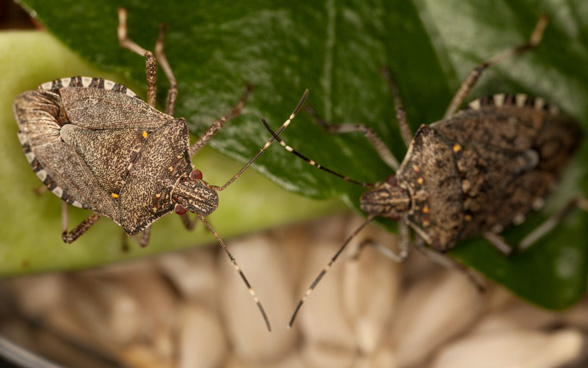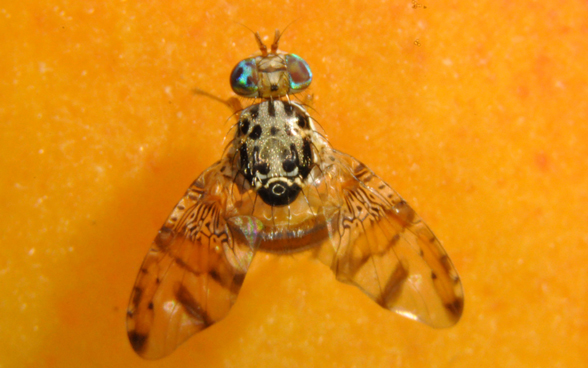Weeds and pests represent a potential risk for agricultural production. The control of insect pests and weeds makes a substantial contribution to the security of production of the Swiss agricultural sector.
The efficacy of current plant protection is the result of the offer of extension advice and the use of various strategies such as monitoring, choice of plant-protection products, promotion of beneficial organisms, adaptation of cultivation techniques or variety selection.

Climate change influences the distribution and development of insect pests, the favourable habitats of their host plants, and the ecological relationships between host plants, insect pests and their natural enemies (Bale et al., 2002; Tylianakis et al., 2008). For the adaptation of control strategies, timely detection of the altered development of native insects and the risk of invasion by non-native insect pests (in German) is essential. Very important in this context is the cross-border collaboration. The European Plant protection Organization (EPPO) and the European Food Safety Authority (EFSA) coordinate the development of common strategies to protect plants against insect pests.
Native Insect Pests
Climate-related changes in the incidence of insect pests are already apparent today. Since 1960, many species have extended their range northwards or to higher altitudes (Bebber et al., 2013). Furthermore, warmer winters have favoured the survival of insect pests and led to higher population densities in the spring (Bale et al, 2002), although hot, dry summers have led, in some cases (in German), to higher insect mortality and reduced population densities.
Because of global warming, the phenological development of insect pests starts earlier in the year and occurs more rapidly (Bell et al., 2015). As a result, many species such as the codling moth (in German) (Cydia pomonella) produce one generation more per year than they did several decades ago (Tobin et al., 2008).
Invasive Insect Pests
The distribution of invasive non-native insects has spread markedly in the last few decades owing to climate change (Seebens et al., 2017). International trade and passenger transport favour the introduction and spread of non-native insect species. Since Switzerland’s future climate is likely to correspond to the present-day climate in the warmer regions of France, the Mediterranean and South-Eastern Europe (Fig. 1), the chances of non-native insect species surviving, spreading and hence becoming established will increase with climate change.
The spotted-wing drosophila (in German) (Drosophila suzukii), the Mediterranean fruit fly (in German) (Ceratitis capitata), the Japanese beetle (in German) (Popillia japonnica), the brown marmorated stink bug (in German) (Halyomorpha halys) and the tomato leaf miner (in German) (Tuta absoluta) have all recently been introduced to Switzerland. Up to now the Alps have represented a barrier against the spontaneous entry of insect pests from southern areas. Depending on situation this ought to be no longer the case in the future (Aluja et al., 2014).
The following pages offer a deeper view of the topic, presenting selected examples and research findings:
Additional Information
Services and Advice
AGRIDEA
Agrometeo
- Homepage
- Insect monitoring (in German)
- European Corn Borer (in German)
- Pea moth (in French)
- Spotted-wing drosophila (in German)
Agroscope
- Pest Forecast for the Fruit-Production Sector (SOPRA, in german)
- Drosophila suzukii (in German)
- Plant Breeding
Bioaktuell (all pages in German or French)
CABI
Institutional
Federal Office for Agriculture (FOAG)
Research Institute of Organic Agriculture (FiBL)
Universities and further research institutions
- Changins School of Viticulture and Enology
- School of Agricultural, Forest and Food Sciences HAFL
- Plantahof (in German)
- Zurich University of Applied Sciences (ZHAW) - Research Group for Environmental Genomics and Systems Biology - Ticks
Swiss Farmers' Union
International organisations
Literature
References Cited in the Text
Aluja, M., Birke, A., Ceymann, M., Guillén, L., Arrigoni, E., Baumgartner, D., Pascacio-Villafán, C. and Samietz, J., 2014. Agroecosystem resilience to an invasive insect species that could expand its geographical range in response to global climate change, Agr. Ecosyst. Environ, 186, 54–63.
Bacon, S.J., Bacher, S., Aebi, A., 2012. Gaps in border controls are related to quarantine alien insect invasions in Europe. PLoS ONE, 7, e47689.
Bale, J.S., Masters, G.J., Hodkinson, I.D., Awmack, C., Bezemer, T.M., Brown, V.K., Butterfield, J., Buse, A., Coulson, J.C., Farrar, J., Good, J.E.G., Harrington, R., Hartley, S., Jones, T.H., Lindroth, R.L., Press, M.C., Symrnioudis, I., Watt, A.D., Whittaker, J.B., 2002. Herbivory in global climate change research: direct effects of rising temperature on insect herbivores. Glob. Change Biol., 8, 1-16.
Bebber, D.P., Ramotowski, M.A.T., Gurr, S.J., 2013. Crop pests and pathogens move polewards in a warming world. Nat. Clim. Change, 3, 985-988.
Bell, J.R., Alderson, L., Izera, D., Kruger, T., Parker, S., Pickup, J., Shortall, C.R., Taylor, M.S., Verrier, P., Harrington, R., 2015. Long-term phenological trends, species accumulation rates, aphid traits and climate: five decades of change in migrating aphids. J. Anim. Ecol., 84, 21-34.
Deutsch, C. A., Tewksbury, J. J., Tigchelaar, M., Battisti, D. S., Merrill, S. C., Huey, R. B., Naylor, R. L., 2018. Increase in crop losses to insect pests in a warming climate. Science, 361, 916–919.
FOEN, 2016. Strategie der Schweiz zu invasiven gebietsfremden Arten. Federal Office for the Environment (FOEN), Bern, Switzerland.
Mazzi, D., Bravin, E., Meraner, M., Finger, R., Kuske, S., 2017. Economic impact of the introduction and establishment of Drosophila suzukii on sweet cherry production in Switzerland. Insects, 8, 1-13.
Seebens, H., Blackburn, T.M., Dyer, E.E., Genovesi, P., Hulme, P.E., Jeschke, J.M., Pagad, S., Pysek, P., Winter, M., Arianoutsou, M., Bacher, S., Blasius, B., Brundu, G., Capinha, C., Celesti-Grapow, L., Dawson, W., Dullinger, S., Fuentes, N., Jager, H., Kartesz, J., Kenis, M., Kreft, H., Kuhn, I., Lenzner, B., Liebhold, A., Mosena, A., Moser, D., Nishino, M., Pearman, D., Pergl, J., Rabitsch, W., Rojas-Sandoval, J., Roques, A., Rorke, S., Rossinelli, S., Roy, H.E., Scalera, R., Schindler, S., Stajerova, K., Tokarska-Guzik, B., van Kleunen, M., Walker, K., Weigelt, P., Yamanaka, T., Essl, F., 2017. No saturation in the accumulation of alien species worldwide. Nat. Commun., 8, 9.
Swiss Science Academies (2016). Brennpunkt Klima Schweiz. Grundlagen, Folgen und Perspektiven. Swiss Academies Reports, 11(5), [available online, 14 June 2018].
Tobin, P.C., Nagarkatti, S., Loeb, G., Saunders, M.C., 2008. Historical and projected interactions between climate change and insect voltinism in a multivoltine species. Glob. Change Biol., 14, 951-957.
Tylianakis, J.M., Didham, R.K., Bascompte, J., Wardle, D.A., 2008. Global change and species interactions in terrestrial ecosystems. Ecol. Lett. 11, 1351-1363.
Additional Reading
Eitzinger, J., Kersebaum K.C., Formayer H., 2009. Landwirtschaft im Klimawandel – Auswirkungen und Anpassungsstrategien für die Land- und Forstwirtschaft in Mitteleuropa. AgriMedia, ERLING Verlag GmbH, Clenze (Germany).
FOEN, 2009: Klimainformationen im Dienste der Ernährungssicherheit. Faktenblatt 4, 3. World Climate Conference, Geneva, Switzerland [available online, 14 June 2018].
Linder, C., Kehrli, P., Viret, O., 2016. Ravageurs et auxiliaires. In La Vigne, vol. 2.
Online Journals
- Agrarforschung Schweiz
- Revue Suisse de Viticulture, Arboriculture et Horticulture
- CABI Book Series: Crop Production Science in Horticulture Series
- CABI Book Series: Invasive Series
- CABI Book Series: Climate Change Series
Last modification 28.09.2023













